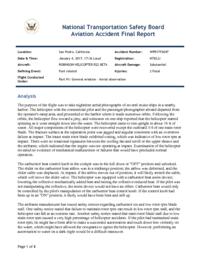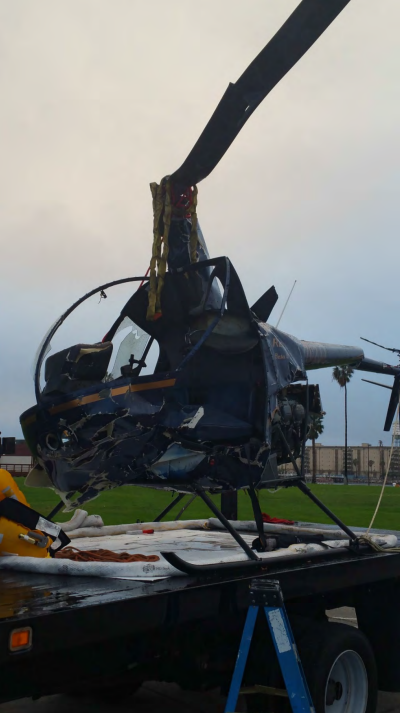
This information is added by users of ASN. Neither ASN nor the Flight Safety Foundation are responsible for the completeness or correctness of this information.
If you feel this information is incomplete or incorrect, you can submit corrected information.
| Date: | Wednesday 4 January 2017 |
| Time: | 17:36 |
| Type: |  Robinson R22 Beta |
| Owner/operator: | JJ Helicopters |
| Registration: | N702JJ |
| MSN: | 3791 |
| Year of manufacture: | 2005 |
| Total airframe hrs: | 5000 hours |
| Engine model: | Lycoming O-360-J2A |
| Fatalities: | Fatalities: 2 / Occupants: 2 |
| Other fatalities: | 0 |
| Aircraft damage: | Substantial |
| Category: | Accident |
| Location: | Pacific Ocean, San Pedro, CA -
 United States of America United States of America
|
| Phase: | Manoeuvring (airshow, firefighting, ag.ops.) |
| Nature: | Survey |
| Departure airport: | Torrance Airport, CA (TOA/KTOA) |
| Torrance Airport, CA (TOA/KTOA) | |
| Investigating agency: | NTSB |
| Confidence Rating: |
The purpose of the flight was to take nighttime aerial photographs of several cruise ships in a nearby harbor. The helicopter with the commercial pilot and the passenger/photographer aboard departed from the operator's ramp area, and proceeded to the harbor where it made numerous orbits. Following the orbits, the helicopter flew toward a jetty, and witnesses on one ship reported that the helicopter started spinning as it went straight down into the water. The helicopter came to rest upright in about 18 ft of water. All major components of the helicopter were recovered except the outboard 3/4 of one main rotor blade. The fracture surface at the separation point was jagged and angular consistent with an overstress failure at impact. The intact main rotor blade exhibited coning, which was indicative of low rotor rpm at impact. There were no rotational signatures between the cooling fan and scroll or the upper sheave and the airframe, which indicated that the engine was not operating at impact. Examination of the helicopter revealed no evidence of mechanical malfunctions or failures that would have precluded normal operation.
The carburetor heat control knob in the cockpit was in the full down or "OFF" position and unlocked. The slider on the carburetor heat airbox was in a midrange position; the airbox was deformed, and the slider cable was displaced. At impact, if the airbox moves out of position, it will likely stretch the cable, which will move the slider valve. The helicopter was equipped with a carburetor heat assist device; lowering the collective mechanically added heat and raising the collective reduced heat. If the pilot was not manipulating the collective, the assist device would not have an effect. Carburetor heat would only be controlled by the pilot's manipulation of the carburetor heat control knob. If the control knob had been up in an "ON" position, it likely would have been bent and still up.
The airframe manufacturer has issued safety notices regarding carburetor ice and low rotor rpm blade stall. One safety notice stated that failure to maintain rotor rpm can result in low rotor rpm stall, and the helicopter can fall at an extreme rate. Another safety notice stated that main rotor blade stall due to low main rotor rpm caused a very high percentage of helicopter accidents. If the pilot had maintained main rotor rpm, he might have been able to make a successful autorotation and touch down less violently on the water, which might have allowed the occupants to egress the helicopter. However, performing an autorotation to water on a dark night would be a difficult maneuver.
The meteorological conditions at the time of the accident were conducive for the formation of carburetor ice, but the carburetor heat control knob was in the "OFF" position. It is likely that the pilot's failure to apply carburetor heat resulted in a loss of engine power due to carburetor ice. During the ensuing forced landing, the pilot did not maintain adequate main rotor rpm, and the helicopter descended rapidly to impact.
Probable Cause: The pilot's failure to use carburetor heat while operating in conditions conducive to carburetor icing, which resulted in a loss of engine power due to carburetor icing. Also causal was the pilot's failure to maintain rotor rpm following the loss of engine power.
Accident investigation:
 |
|
Sources:
NTSB
2. FAA register: http://registry.faa.gov/aircraftinquiry/NNum_Results.aspx?NNumbertxt=N702JJ
3. https://abc7.com/news/2-bodies-pulled-from-helicopter-wreckage-off-coast-of-san-pedro/1687780/
4. http://www.foxla.com/news/local-news/crews-search-la-harbor-area-after-helicopter-crash-two-believed-dead
5. https://www.ocregister.com/2017/01/05/rescue-crews-search-for-helicopter-with-2-aboard-last-seen-above-port-of-los-angeles/
6. https://losangeles.cbslocal.com/2017/01/04/fire-crews-search-waters-off-san-pedro-in-response-to-report-of-helicopter-down/
Location
Images:

Photo(c): NTSB
Media:
#NTSB issues preliminary report on fatal Port of Los Angeles #R22 helicopter crash: https://t.co/1puGv4hmuo
— Vertical Magazine (@verticalmag) January 14, 2017
Revision history:
| Date/time | Contributor | Updates |
|---|---|---|
| 05-Jan-2017 11:45 | Aerossurance | Added |
| 05-Jan-2017 17:16 | Geno | Updated [Source] |
| 05-Jan-2017 20:55 | harro | Updated [Total fatalities, Narrative] |
| 13-Jan-2017 15:59 | Aerossurance | Updated [Time, Location, Source, Narrative] |
| 14-Jan-2017 14:27 | Aerossurance | Updated [Source, Embed code, Narrative] |
| 16-Dec-2017 14:54 | ASN Update Bot | Updated [Time, Operator, Departure airport, Destination airport, Source, Embed code, Damage, Narrative] |
| 14-Aug-2018 18:32 | Dr.John Smith | Updated [Time, Operator, Location, Nature, Departure airport, Destination airport, Source, Embed code, Narrative] |
| 06-Mar-2022 23:18 | Captain Adam | Updated [Location, Departure airport, Destination airport, Source, Narrative, Photo] |
Corrections or additions? ... Edit this accident description
The Aviation Safety Network is an exclusive service provided by:


 ©2024 Flight Safety Foundation
©2024 Flight Safety Foundation